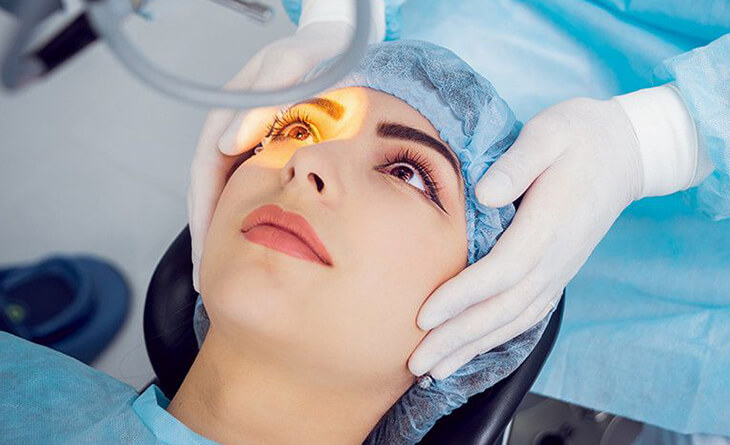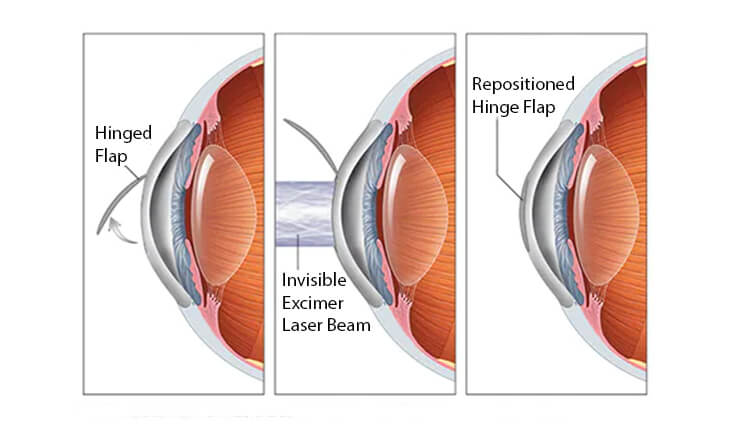Lasik Surgery
Lasik surgery is a cosmetic procedure that corrects refractive errors like myopia, hyperopia, astigmatism, and presbyopia. While these conditions usually require glasses or contact lenses, getting refractive or LASIK eye surgery is a permanent solution.
As an expert ophthalmologist, Dr Anisha Gupta is proficient in all the latest refractive surgery techniques. While LASIK remains the most popular, there are several newer techniques that Dr Gupta practices to bring her patients ideal results today. These include SMILE, ICL, and Refractive Lens Exchange. Having experts in these techniques ensures the best solutions for every condition.

Are you a fit candidate for LASIK eye surgery?
To qualify for lasik surgery, you need to meet the following standards:
When you visit an ophthalmologist for a consultation, they take your entire medical history into account to optimise your treatment path. This allows them to offer the highest quality, most effective procedure for your refractive error with a long term stable result.
Lasik Eye Surgery – The Procedure
LASIK eye surgery is an outpatient surgery that changes the shape of the cornea, so that the light focuses on the retina.
Your surgeon first numbs your eye with eye drops before placing an eyelid clip over it to prevent blinking.
After this, they use a laser (bladeless) or microkeratome (blade) to make a flap in the corneal tissue, which they then lift and fold back. They then reshape your cornea with the laser, correcting the refractive error.
The laser ensures precision, with targeted pulses to successfully reshape the cornea. After reshaping, the surgeon closes the flap, which re-attaches itself and heals without any sutures.
Within the LASIK procedure, you have various options. These include:
While LASIK may be most common, the procedure does have an upper limit on how much power your ophthalmologist can remove. This limit depends on corneal thickness. Also, some eyes may not have a cornea fit for LASIK. Therefore, you may need some other specialised techniques for optimum results.
Small Incision Lenticule Extraction (SMILE)
SMILE is a modern surgical procedure that uses the Femto Laser to create a corneal lenticule. This is a tiny disc-shaped piece of the cornea. The laser sculpts this and then makes an incision in the cornea through which your surgeon can access the lenticule.
Your ophthalmologist removes the lenticule, reshaping the cornea in the process. The incision is very tiny, and this procedure has a very high success rate and lower incidence of dry eyes.
Implantable Collamer Lens (ICL)
ICL are incredibly thin lenses your ophthalmologist implants over the natural lens inside the eye. They are similar to contact lenses, but they do not move or irritate or need to be removed, as they are placed inside the eye.
The first step of the procedure is determining if there is enough space for the ICL. If yes, Dr Gupta makes a small incision in your cornea and inserts the ICL. ICLs are recommended for patients unfit for lasik either due to high power or unfit cornea. With ICL, powers as high as -20 to -25 can be removed.
Clear Lens Extraction or Refractive Lens Exchange (CLE/RLE)
If you cannot undergo ICL, SMILE or LASIK, CLE/RLE is the best option for you. This procedure involves replacing your natural lens with an intraocular lens (IOL).
Through a tiny incision, your natural lens is removed and replaced with an IOL, inserted through the same incision. There is no need for sutures as the incision closes on its own, offering immediate results. This can also be useful in correcting presbyopia or near vision glasses that come after 40 years of age.

Recovery After LASIK Eye Surgery and Other Refractive Surgeries
Today, the latest technology and high-quality techniques minimise downtime and optimise recovery. For LASIK and SMILE, both eyes are done in the same sitting. For ICL and CLE/RLE, your surgeon may prefer to do one eye at a time.
Recovery after LASIK eye surgery and other refractive surgeries includes:
Using modern advancements in lasik eye surgery, Dr Gupta offers effective procedures that improve the quality of life for her patients, cementing herself as a leading ophthalmologist in Delhi.
Contact Dr Anisha Gupta today for a permanent solution to your refractive errors!
